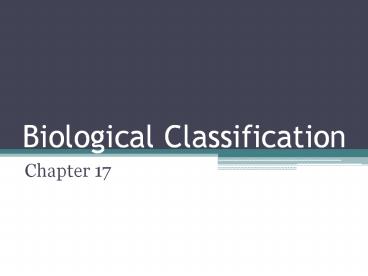Biological Classification - PowerPoint PPT Presentation
Title:
Biological Classification
Description:
Biological Classification Chapter 17 iRespond Question Master A.) Response A B.) Response B C.) Response C D.) Response D E.) Response E Percent Complete 100% 00:30 ... – PowerPoint PPT presentation
Number of Views:258
Avg rating:3.0/5.0
Title: Biological Classification
1
Biological Classification
- Chapter 17
2
Bellringer
- Write down an example of an organization system
that you use. How is it helpful?
3
Standard
- SB3. Students will derive the relationship
between single-celled and multi-celled organisms
and the increasing complexity of systems. - b. Compare how structures and function vary
between the six kingdoms (archaebacteria,
eubacteria, protists, fungi, plants, and
animals). - EQ In what ways do the six kingdoms of living
things differ from each other?
4
Taxonomy
- The practice of naming and classifying organisms
is called taxonomy. - Taxonomic systems use categories to organize
organisms. - The general term for any one of these categories
is a taxon (plural, taxa).
5
Dichotomous Keys
- A dichotomous key can be used to identify an
unknown organism based on observable
characteristics - Consists of two part statements that describe
characteristics of organisms. - As the user makes a choice of a characteristic,
they are led to a new branch of the key. - For example, lets consider the Norns on the next
page
6
1. Has pointed ears ......................
............ ........ go to 3Has rounded ears
.................... ............ ..........go to
2 2. Has no tail .............................
............ ........... KentuckyusHas tail
............................ ............
.................. Dakotus 3. Ears point upward
............ ............ ................ go to
5Ears point downward ........... ............
.............go to 4 4. Engages in waving
behavior ......... ............ ... DallusHas
hairy tufts on ears ..............................
......Californius 5. Engages in waving behavior
........................... WalaWala Does not
engage in waving behavior ..............go to
6 6. Has hair on head ............................
................. Beverlus Has no hair on head
(may have ear tufts) .......go to 7 7. Has a tail
..................................................
........ YorkioHas no tail, aggressive
...................................... Rajus
A
B
C
D
H
G
F
E
- www.biologycorner.com/worksheets/dichoto.html
7
Levels of taxonomy
- The eight basic levels of modern classification
are - Domain
- Kingdom
- Phylum
- Class
- Order
- Family
- Genus
- Species
- Did
- King
- Philip
- Come
- Over
- For
- Ginger
- Snaps?
8
Carl Linnaeus
- Swedish scientist who introduced a two-word
naming system called binomial nomenclature. - His system included the genus name and a single
descriptive word for each species. - This is an organisms scientific name.
9
Rules for Scientific Names
- No two species can have the same scientific name.
- All scientific names are made up of two Latin or
Latin-like (sometimes Greek) terms. - All the members of a genus share the genus name
as the first term. - The second term is called the species identifier,
and often describes the species.
10
- .
- The genus, which is usually a noun, is
CAPITALIZED. The species, usually an adjective
that describes the noun, is not capitalized.
11
- Scientific names can be abbreviated by using the
capital letter of the genus and a period and the
species name. - Ex. Panthera leo (lion)
- P. leo
- Panthera tigris
(tiger) - P. tigris
- Quercus rubrum (red oak)
- Q. rubrum
12
- Members of the same genus are closely related.
Only members of the same species can interbreed
(under natural conditions)
13
Why do we need scientific names?
- Dolphin (marine mammal)
- Dolphin (fish)
14
Taxonomy of the Dolphins
- Bottlenose Dolphin
- Mahi Mahi (Dolphin Fish)
- DOMAIN Eukarya
- KINGDOM Animalia
- PHYLUM Chordata
- CLASS Mammalia
- ORDER Cetacea
- FAMILY Delphinidae
- GENUS Tursiops
- SPECIES Tursiops truncatus
- DOMAIN Eukarya
- KINGDOM Animalia
- PHYLUM Chordata
- CLASS Osteichthyes
- ORDER Perciformes
- FAMILY Coryphaenidae
- GENUS Coryphaena
- SPECIES Coryphaena hippurus
15
(No Transcript)
16
- In biology, there is an organizational technique
called cladistics. Cladistics uses a bunch of
characteristics to group organisms in a
cladogram based on whether they possess or
lack each of those characteristics. To make a
cladogram, you look at your list of
characteristics and your list of organisms and
you say things like, Does this thing have jaws?
If yes, proceed. If not, branch off into an out
group spur. Same for lungs? yes/no and fur?
yes/no and so on until you get a rough family
tree like this
17
Create Your Own Cladogram
- To make a cladogram, you must first look at the
animals you are studying and establish
characteristics that they share and ones that are
unique to each group. For the animals on the
table, indicate whether the characteristic is
present or not. Based on that chart, create a
cladogram like the one pictured above. - Frog
- Tiger
- Human
- DRAW YOUR CLADOGRAM
cells backbone legs hair Opposable Thumbs
slug y
catfish y
frog y
tiger y
human y
18
(No Transcript)
19
The Six Kingdoms of Life
- Domain Bacteria all organisms in this domain are
prokaryotic - Kingdom Eubacteria
- Domain Archaea all organisms in this domain are
prokaryotic - Kingdom Archaebacteria
- Domain Eukarya all organisms in this domain are
eukaryotic - Kingdoms include Protista, Fungi, Plantae,
Animalia
20
(No Transcript)
21
Domain Bacteria, Kingdom Eubacteria
22
Domain Archaea, Kingdom Archaebacteria
23
Domain Eukarya, Kingdom Protista
24
Domain Eukarya, Kingdom Fungi
25
Domain Eukarya, Kingdom Plantae
26
Domain Eukarya, Kingdom Animalia
27
(No Transcript)































